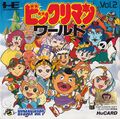Wonder Boy in Monster Land is a platform and role-playing game developed by Westone. It was published by Sega for the arcades in 1987 and for the Sega Master System in 1988; Activision released the game for the Amiga in 1987 and for several more popular home computers in 1989. The game was titled Super Wonder Boy: Monster World in Japan. Jaleco retooled the game for the Famicom to resemble the Chinese novel Journey to the West, and Hudson Soft retooled it for the PC Engine to resemble the Bikkuriman anime franchise. Tectoy released the game in Brazil under Mônica no Castelo do Dragão and retooled it to resemble Brazilian comic book series Monica's Gang. The game was released for mobile phones in 2005 and for the Wii's Virtual Console service in 2008 in Japan and in 2009 in North America and Europe.
The game is the sequel to the 1986 game Wonder Boy and takes place eleven years after the events in the previous game. After enjoying over a decade of peace on Wonder Land following the defeat of the evil King by Tom-Tom, later bestowed the title "Wonder Boy", a fire-breathing dragon called the MEKA dragon appeared; he and his minions conquered Wonder Land, turning it into "Monster Land". The people, helpless due to their lack of fighting skill, call for Wonder Boy, now a teenager, to destroy the monsters and defeat the MEKA dragon. Players control Wonder Boy through twelve linear levels as he makes his way through Monster Land to find and defeat the MEKA dragon. Players earn gold by defeating enemies and buy weapons, armor, footwear, magic, and other items to help along the way.
Wonder Boy in Monster Land received mixed overall praise. While the arcade version amassed moderate sales, the ZX Spectrum, Commodore 64, and Atari ST versions received mixed praise and criticism, whereas the Amiga version received mostly negative reception. Reviews praised the game for its colorful graphics, smooth controls, gameplay, and replay value; criticisms included very slow multi-load times on the home computer versions, sub-quality sound, and reduced gameplay area size. The Master System version received overall positive reviews in all aspects and has been highly regarded as one of the better titles in the Master System library.
-
TurboGrafx-16 cover art.
-
Japanese Sega Mark III cover art.
-
Famicom cover art.
-
Activision cover art.




